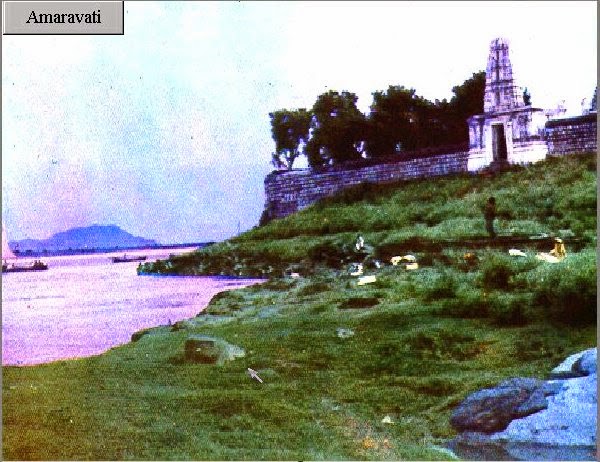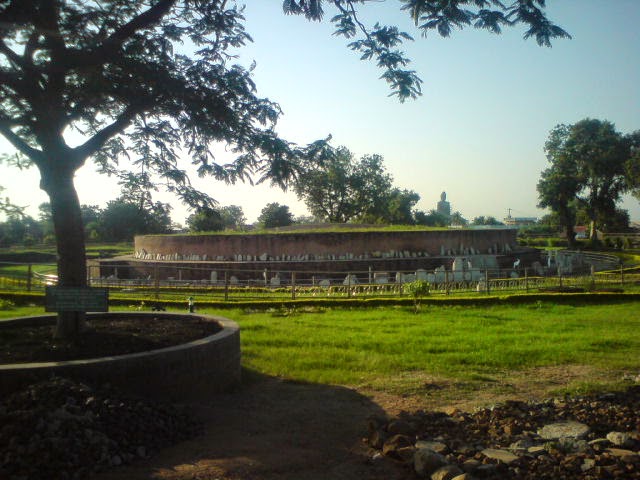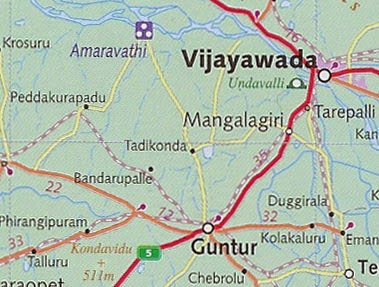When the Maurya dynasty fell (post Emperor Ashoka) a giant kingdom rose south of the Vindhya mountain range (the traditional south-north divide in India). They were the Andhra Satavahanas.
The Andhras are a curious mix: most likely Maratha-Telugu in origin (Shudras or Other Backward Caste- OBC), Aryan-like for war-faring and Dravidian-like in devotion (followers of Shiva). In that sense they can claim to be the first son-of-the-soil, north meets south, Hindu as we know now, empire.
During Ashoka’s time (and even during the Satvahana period) Amaravati
was reputed as one of the fore-most Buddhist centers (stupa pix above,
see below for wiki excerpts), however when Hieun Tsang paid a visit in
640 CE, Hindus were again in the ascendant.
Just like the Shia vs. Sunni 1000 years war, India has
experienced long, brutal battles between the followers of Shiva and Vishnu.
This is a major point of contention between hindutva-vadis and marxist
historians, examples of Turk-Mughal led genocides are countered by examples of Shaivaite vs. Vaishnavaite genocides (similar to the Gujarat 2002 vs. Punjab 1984 we are holier than thou arguments). Amaravati is the seat of Amareswara (Shiva) and Chamundeshwari (Shakti).
Intra-Hindu religious wars died out mainly due to the imposition of 1000 Years slavery (TM). There are now the five major
paths – as authorized by the Prophet Adi Shankaracharya (from Kerala) –
Ganapati, Shiva, Vishnu, Shakti and Surya. Incidentally, the Brahminical pecking
order reserves the elite positions for the Namboodiris (also from Kerala).
Thus only Namboodiri priests can ring the bell in Kedarnath, the al-Aqsa
of the Hindus.
We note that in 2014 the Hindu leadership have anointed Varanasi as the new Jerusalem- this is also the seat of Vishwanath (Shiva) and Annapurna (Shakti). In that sense the new Hindu kingdom is a renewal of the old Andhra kingdom. The more things change the more they remain the same.
……..
The
new capital city of Andhra Pradesh will be built around the ancient town
of Amaravati, once home to the powerful Satavahana dynasty, a senior
minister and highly-placed government sources said.
With chief
minister N Chandrababu Naidu keen on developing a new city on both
sides of the Krishna river, officials zoomed in on Amaravati after
realising that price of land in Mangalagiri, Babu’s earlier choice, was
too high. Plans are afoot to link a few mandals in Krishna and
Guntur districts, spread on either side of the river, with a six to
eight lane bridge between Achampet mandal in Guntur and Nandigama in
Krishna district. Another bridge will also be built between
Kanchikacherla in Krishna district and Amravati in Guntur district,
officials who are working on the blueprint said.
….
….
[ref. Wiki] The Śātavāhana Empire ….was a royal Indian dynasty. The territory of the empire covered much of India
from 230 BCE …until around 220 CE. Sātavāhanas started out as feudatories to the Mauryan dynasty, but declared independence with its decline. They are known for their patronage of Hinduism.
The Sātavāhanas were one of the first Indian states to issue coins
struck with their rulers embossed. They formed a cultural bridge and
played a vital role in trade as well as the transfer of ideas and
culture to and from the Indo-Gangetic Plain to the southern tip of India.
They had to compete with the Sungas and then the Kanvas of Magadha to establish their rule. Later, they played a crucial role to protect a huge part of India against foreign invaders like the Sakas, Yavanas and Pahlavas. In particular their struggles with the Western Kshatrapas went on for a long time. The great rulers of the Satavahana Dynasty Gautamiputra Satakarni and Sri Yajna Sātakarni were able to defeat the foreign invaders like the Western Kshatrapas and stop their expansion. In the 3rd century CE the empire was split into smaller states.
…….
[ref. Wiki] The recorded history of Amaravati and nearby Dharanikota dates from 2nd century BCE. It was the capital of Andhra Satavahanas who ruled from 2nd century BCE to 3rd century CE.
After the decline of Satavahanas, Andhra Ikshvakus and later Pallava kings ruled Krishna river valley. Subsequently, Eastern Chalukyas and Telugu Cholas held sway over the region. Kota Kings were in control of Amaravati during the medieval times. Kota kings were subdued by Kakatiyas in 11th century CE and Amaravati became part of the unified Telugu empire.
……..
[ref. Wiki] The town was the site of a great Buddhist stupa originally built during the reign of emperor Ashoka. It was completed in 200 CE. It is decorated with carved panels which tell the story of Buddha’s life. The region between Krishna and Godavari rivers was an important place for Buddhism from the 2nd century BCE and some ancient sculpture in low relief has been found here.
….
During the Satavahana period (2nd century BCE-3rd century CE), Dharanikota
near Amaravati was chosen as the capital. The stupa was then adorned
with limestone reliefs and free standing Buddha figures. During the
period of the decline of Buddhism, this stupa was also neglected and it was buried under rubble. There is a 14th-century inscription in Sri Lanka which mentions repairs made to the stupa and after that it was forgotten.
…
Around the year 1796 CE, Colonel Colin Mackenzie, who visited the
site twice, prepared drawings and sketches of the relics in the area.
Eventually, several European scholars including Sir Walter Smith, Robert
Sewell, James Burgess and Alexander Rea excavated the site and
unearthed many sculptures that once adorned the stupa. Many bas-relief medallions and paneled friezes decorated the Amaravati stupa.
….
Similar to Sanchi Stupa,
the stupa was decorated with carvings of life and teachings of Buddha
and events of Jataka Stories, e.g. taming of a rogue elephant by Buddha.
The 95 ft tall stupa was made of brick with a circular dome and
platforms protruding in four cardinal directions. Recent excavations
have revealed remains of an Ashokan pillar, the first such example of Mauryan art to be found in South India.
…
This stupa is related to the Vajrayana teachings of Kalachakra, still practiced today in Tibetan Buddhism. According to the Kalachakra tantra texts, Suchandra, the King of Shambhala and many of his retinue received the initiation into this practice by the historical Buddha. For this reason, the Dalai Lama of Tibet conducted a Kalachakra initiation at this location in 2006.
….
Art historians regard the Amaravati art as one of the three major
styles or schools of ancient Indian art, the other two being the Gandhara style and the Mathura
style. Some of the Buddhist sculptures of Amaravati betray a
Greco-Roman influence that was the direct result of the close trade and
diplomatic contacts between South India and the ancient Romans. Indeed, Amaravati has itself yielded a few Roman coins. The Government Museum at Egmore (Madras Museum) and British Museum, London host the “Amaravati Gallery”.
….
Chinese traveller and Buddhist monk Hiuen Tsang (Xuanzang)
visited Amaravati in 640 CE, stayed for sometime and studied
‘Abhidhammapitakam’. He observed that there were many Viharas and some
of them were deserted, which points out that Hinduism was gaining ground at that time. Xuanzang wrote a glorious account of the place, Viharas and monasteries that existed.
……
Link(1): http://timesofindia.indiatimes.com/india/Andhra-Pradesh-capital-in-Amaravati/articleshow/37602031.cms
Link(2): http://www.bharatadesam.com/history/satavahana_empire.php
…….
regards



